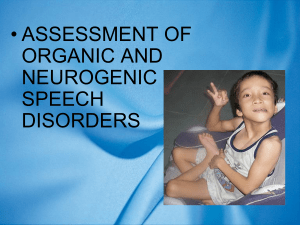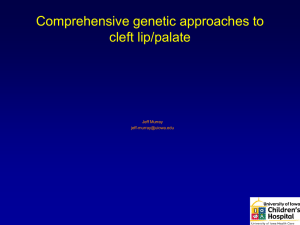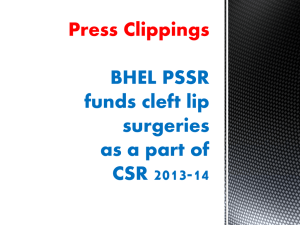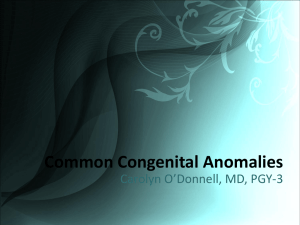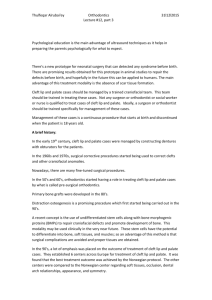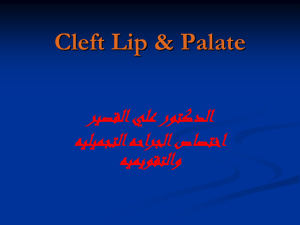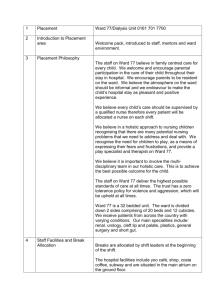Nonsyndromic genes
advertisement
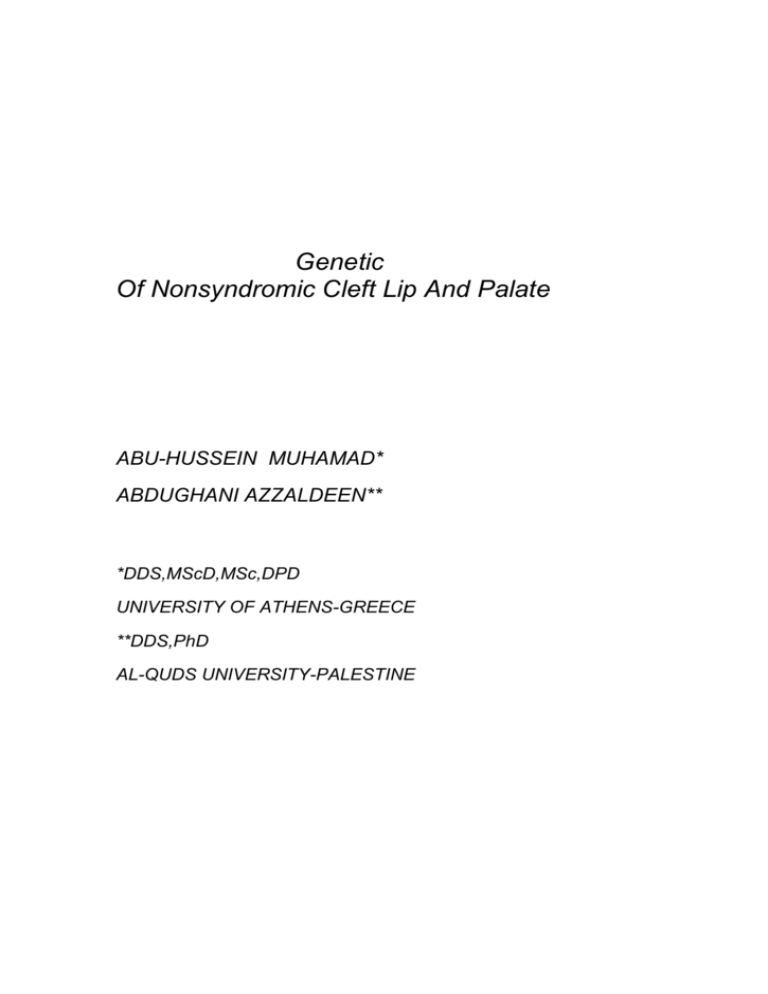
Genetic Of Nonsyndromic Cleft Lip And Palate ABU-HUSSEIN MUHAMAD* ABDUGHANI AZZALDEEN** *DDS,MScD,MSc,DPD UNIVERSITY OF ATHENS-GREECE **DDS,PhD AL-QUDS UNIVERSITY-PALESTINE Orofacial clefts, particularly non-syndromic cleft lip with or without cleft palate (CL/P) are the most common craniofacial deformities, affecting one in every 700 to 1000 newborns worldwide. Numerous efforts have been made to understand the etiology of CL/P so as to predict its occurrence and to prevent it from occurring in the future. In the recent years, advances in genetics and molecular biology have begun to reveal the basis of craniofacial development. Various genetic approaches, including genome-wide and candidate gene association studies as well as linkage analysis, have been undertaken to identify aetiologic factors, but results have often been inconclusive or contradictory. These results may support the presence of aetiologic heterogeneity among populations and the presence of multiple genes involved in the aetiology of CL/P. Despite these difficulties, several different genes have been implicated in harbouring genes that contribute to the aetiology of CL/P. In conclusion, the genetic basis of CL/P is still controversial because of genetic complexity of clefting. Key words : Orofacial clefts, genetics, candidate genes INTRODUCTION Cleft lip (CL), cleft lip with or without cleft palate (CL/P) and isolated cleft palate (CP), collectively termed oral clefts (OC), are the second most common birth defects among newborn. These defects arise in about 1 in 700 liveborn babies, with ethnic and geographic variation. Approximately 75% of CL/P and 50% of CP cases are isolated defects and no other deformities are found in those children. Those OCs are therefore called nonsyndromic (1). Although OC is usually not a life-threatening condition, many functions such as feeding, digestion, speech, middle-ear ventilation, and hearing, respiration, facial and dental development can be disturbed because of the structures involved. These problems can also cause emotional, psychosocial and educational difficulties. Affected children need multidisciplinary care from birth until adulthood (2). Orofacial clefts pose a burden to the individual, the family, and society, with substantial expenditure, and rehabilitation is possible with good quality care. Care for children born with these defects generally includes many disciplines – nursing, facial plastic surgery, maxillofacial surgery, otolaryngology, speech therapy, audiology, counselling, psychology, genetics, orthodontics, and dentistry. Fortunately, early and good quality rehabilitation of children with OC usually gives satisfactory outcomes. Identification of etiological factors for OC is the first step towards primary prevention. Genetic factors contributing to CL/P formation have been identified for some syndromic cases, but knowledge about genetic factors that contribute to nonsyndromic CL/P is still unclear. The high rates of familial occurrences, risk of recurrence, and elevated concordance rates in monozygotic twins provide evidence for a strong genetic component in nonsyndromic CL/P. However, concordance in monozygotic twins ranges between 40% and 60%, which means that the exact inheritance pattern of OC is more complex. It has been suggested that the development of nonsyndromic OC occurs as a result of the interaction between different genetic and environmental factors (3,4,5,6). The identification of the genes responsible for diseases has been a major focus of human genetics over the past 40 years. The introduction of modern molecular methods, experimental animal knockout models and advances in the technique of gene mapping have provided new candidate genes for orofacial clefting, both for syndromic and nonsyndromic cases. However, the results of earlier candidate-gene-based association studies, performed in different populations, have been conflicting, with only a few candidate loci being implicated in OC phenotypes. This inconsistency indicates the challenges in searching associations with a relatively rare phenotype such as nonsyndromic clefting. To date, genetic approaches to nonsyndromic CLP have included: linkage analysis; association studies; identification of chromosomal anomalies or microdeletions in cases; and direct sequencing of DNA samples from affected individuals (7). These methods can be applied to candidate genes or genome-wide strategies can be used. Each approach has its own advantages and disadvantages, some of which will depend on the underlying genetic architecture of the disease, as well as the realities of economics and technology. Findings of linkage studies have suggested various loci could have a causal role in CL/P, including regions on chromosomes 1, 2, 4, 6, 14, 17, and 19 (MTHFR, TGF-α, D4S175, F13A1, TGF-β3, D17S250, and APOC2), with putative loci suggested at 2q32–q35 and 9q21–q33 (8). Inconsistent results could be caused by the small size of the studies or genetic heterogeneity association studies. Some genes function as growth factors (eg, TGF-α, TGFβ3), transcription factors (MSX1, IRF6, TBX22), or factors that play a part in xenobiotic metabolism (CYP1A1, GSTM1, NAT2), nutrient metabolism (MTHFR, RARA) or immune response (PVRL1, IRF6) (2). The most intensively investigated genes have been the TGF-α (9,10, 11) and MTHFR (12,13) genes. Inconsistent data have demonstrated the challenges of researching genedisease associations and related interactions. However, IRF6 has shown consistent evidence of association with CL/P across populations of different ancestry (14, 15, 16,17). Genes implicated in lip and palate development Fogh-Andersen (1942) provided the first population-based evidence that OC has a strong genetic component. Fraser (1970) separated cleft palate only (CPO) and CL/P. There is evidence that families with patients affected by OC have a different genetic background. Conventionally, it has been decided to classify patients with CP only and the remaining patients as CL/P. The high rates of familial occurrences, recurrence risks, and elevated concordance rates in monozygotic twins provide evidence for a strong genetic component in nonsyndromic CL/P. The disorder has a complex inheritance pattern with no clear mode of inheritance and reduced penetrance, with a positive family history for clefting in approximately one third of patients. A sibling risk ratio of approximately 40 has been reported, and there is a 2–5% increased risk for offspring of affected individuals. Concordance in monozygotic twins ranges between 40% and 60%, but it is only 5% in dizygotic twins (1,4,5,6). The lack of total concordance in monozygotic twins suggests that genetic factors alone do not fully account for the pathogenesis of the phenotype; this discordance may be a result of either some degree of nonpenetrance, perhaps as a consequence of random developmental events, or environmental influences in utero. However, the highly increased monozygotic twin concordance does strongly support a major genetic component to orofacial clefting (1,3). The advent of gene targeting technology and basic conventional techniques using animal models has led to the identification of genes associated with known and unknown etiologic factors. Animal models, with clefts arising spontaneously or as a result of mutagenesis experiments, provide another exciting avenue for gene mapping. The mouse is an excellent model for studying human clefting because the development of craniofacial structures in these two species is remarkably similar. Whereas CP is a common phenotype in the mouse, CL is rare (18). Conservation of genes and linkage relationships between mice and humans is well documented, and the chromosomal location of a gene in humans can often be predicted from its genetic map position in mice. Development of the orofacial complex is very similar between mouse and human embryos, and much of the understanding of developmental mechanisms in humans has been inferred from mice (19). It has become evident that CL/P is heterogeneous, and different chromosome regions such as 1q, 2p, 4q, 6p, 14q and 19q have been claimed to contain a clefting locus (8). Nonsyndromic genes Approximately 75% of CL/P and 50% of CP cases are isolated, nonsyndromic OCs (2). Most studies of nonsyndromic clefts to date have focused on CL/P rather than isolated CP. This has been biased perhaps by the larger numbers of cases, easier ascertainment and less confusion from confounding syndromes. Mutation screens of more than 20 CL/P candidate genes find that 2–6% of the total number of individuals with nonsyndromic CL/P have mutations in genes such as MSX1, FOXE1, GLI2, JAG2, LHX8, SATB2, RYK1 and others (21,13). The large majority of individuals with CL/P (94–98%) do not have mutations in any of a wide range of plausible candidate genes. The role of genetic factors in determining CP is documented by recurrence risk (Fraser, 1970) and monozygotic twin concordance (22), but thus far there is no evidence of any single gene acting as a major factor inthe etiology of malformation. In isolated CP, a major genetic component with a relatively small number of interacting causative loci has been suggested and the final phenotype is the result of gene products that interact in many ways with one another and the environment. A.Chromosome 1 A.1. IRF6 – interferon regulatory factor 6; 1q32.3–q41 expression of interferon-alpha and interferon-beta after viral infection. Zucchero et al. (2004) found evidence for overtransmission of several single nucleotide polymorphisms (SNPs) in IRF6 in nonsyndromic CLP, several of which were confirmed by others (23,1). Mutations in the IRF6 gene are known to be associated with van der Woude syndrome and popliteal pterygium syndrome. Variation at the IRF6 locus is responsible for 12% of the genetic contribution to CL/P at the population level and triples the recurrence risk for a child with a cleft in some families(24). A positive association between IRF6 variants and OC has been confirmed in multiple populations and independently replicated (11). Metaanalysis of 13 genome scans confirmed that IRF6 is one of the main candidate genes that has common polymorphic variants, which can increase the risk of CL/P (8). Further functional analyses to identify downstream target genes and interacting proteins is important to the understanding of the role of IRF6 in palatal development, especially given (1) the overlap of IRF6 gene expression at the medial edge of the palatal shelves immediately before and during fusion with that of transforming growth factor beta 3 (TGF-β3) in mice, and (2) the proposed role of the SMIR domain of IRF6 in mediating interactions between IRFs and Smads, a family of transcription factors known to transduce TGF-β signals (25). It has been shown that integration of IRF6 and the Notch ligand Jagged2 function is essential for the control of palatal adhesion and fusion competence via a combined role in the control of oral periderm formation and differentiation (26). Van der Woude syndrome VWS represents the most common single-gene cause of cleft lip and cleft palate, accounting for about 2% of all individuals with CL/P (27) or roughly one in 35,000 to one in 100,000 in the European and Asian populations (28)Patients with VWS have clefts of the lip and palate, missing teeth in approximately 25% of cases, and pits in the lower lip in approximately 85% of cases. Both cleft types, CL/P and CP only, occur in individuals with VWS in the same proportions as in the general population, about two to one respectively (28,29). suggest that individuals with VWS are more likely to have hypoplasia of the mandible and maxilla than isolated cases with the same cleft phenotype. Sequence analysis of the IRF6 coding region (exons 1 through 9) detects mutations in approximately 70% of individuals with VWS. Mutations in exons 3, 4, and 7–9 account for 80% of known VWS-causing mutations (30). Popliteal pterygium syndrome (PPS). Prevalence is approximately one in 300,000. The PPS phenotype includes CL/P in approximately 91–97% of individuals; fistulae of the lower lip in 45% of cases (5,6); webbing of the skin extending from the ischialtuberosities to the heels, bifid scrotum and cryptorchidism in males, hypoplasia of the labia majora in females, syndactyly of fingers and/or toes, and anomalies of the skin around the nails (7,8). Most missense mutations that cause PPS are located in IRF6 exon 4. It appears likely that certain mutations (R84H, R84C) are more apt to cause PPS than VWS. A cluster of missense mutations in the DNA-binding domain are more commonly seen in families with PPS. However, families may include individuals with features of only VWS, and other members with the additional features of PPS. A.2. MTHFR – methylenetetrahydrofolate reductase; 1p36.3 MTHFR is an important enzyme in folate metabolism. The MTHFR gene encodes an enzyme called methylenetetrahydrofolate reductase. This enzyme plays a role in processing amino acids, the building blocks of proteins. Methylenetetrahydrofolate reductase is important for a chemical reaction involving forms of the vitamin folate (also called folic acid or vitamin B9). Specifically, this enzyme converts 5,10-methylenetetrahydrofolate to 5methyltetrahydrofolate. This reaction is required for the multistep process that converts the amino acid homocysteine to another amino acid, methionine. The body uses methionine to make proteins and other important compounds. In 1998, Shaw reported an association between CL/P and genetic variation at the MTHFR locus. Since that initial report, there have been a number of studies reporting the association between CL/P and MTHFR variant (9,10,14 ). The gene encoding the MTHFR enzyme is known to have at least two functional polymorphisms: 677 C>T (rs1801133, c.665C>T, p. Ala222Val) and 1298 A>C (rs1801131, c.1286A>C, p. Glu429Ala). The homozygous MTHFR 677TT genotype results in a thermolabile enzyme with reduced activity (18). A second polymorphism in the MTHFR gene, an A-to-C substitution at nucleotide 1298, also results in decreased MTHFR activity but is not associated with higher homocysteine or lower plasma folate levels (21). Animal studies suggest that a decreased conversion of homocysteine to methionine could be a crucial step in causing neural tube defects. It has been shown that rat embryos in culture require methionine for neural tube closure (Mills et al., 1996). Several casecontrol studies have attempted to implicate this polymorphism in clefting etiology but results have not been encouraging. Associations have only been found in small studies (13). B.Chromosome 2 B.1. TGF-α – Transforming growth factor alpha; 2p13 reversibly confer the transformed phenotype on cultured cells. The TGF-α receptor is identical to the epidermal growth factor (EGF) receptor. TGF-α shows about 40% sequence homology with EGF and competes with EGF for binding to the EGF receptor, stimulating its phosphorylation and producing a mitogenic response. The biological activities of TGF-α resemble those of EGF since both factors bind to the same receptor. Some biological activities of TGF-α are, however, stronger than those of EGF. TGF-α is thought to be the fetal form of EGF. The physiological role of TGF-α is probably the control of epidermal development during development and differentiation of the cells (23). TGF-α also affects bone formation and remodelling by inhibition of the synthesis of collagen and release of calcium. These effects are more pronounced than those of EGF. TGF-α also promotes the generation of osteoblast-like cells in long-term bone marrow cultures. (31). However, other studies have not been able to replicate this finding by either linkage or association (16). A study combining 13 linkage scan studies (Marazita et al., 2004), revealed positive results, corroborating the hypothesis that TGF-α is a modifier rather than being necessary or sufficient to cause clefting. Chromosomal abnormalities involving only duplication of chromosome 2q are rare. Duplication within the long arm of chromosome 2 may cause CPO and Pierre Robin sequence (32) C.Chromosome 4 C.1MSX1 – msh homeobox; 4p16.3–p16.1 MSX genes are homeobox-containing genes homologous to the Drosophila msh gene . MSX proteins function as transcriptional repressors in cellular differentiation (33) and interact with other protein factors to modulate differentiation and proliferation (34). Embryonic expression patterns of MSX genes are consistent with the role of Msx proteins in epithelial-mesenchymal tissue interactions during craniofacial development (33). The role of Msx proteins in active morphogenesis is suggested by the lack of Msx1 expression in cells undergoing terminal differentiation (Woloshin et al., 1995) and by restricted cellular expression of Msx1 transcript during periods of rapid cellular proliferation(Simon et al., 1995). Point mutations in MSX1 appear to contribute to approximately 2% of all CL/P cases (21). Msx1-deficient mice develop craniofacial abnormalities of the nasal, frontal, and parietal bones, as well as CP. The occurrence of CP in Msx1 knockout mice aided the identification of a MSX1 mutation cosegregating with tooth agenesis, CL/P and CP (21). It has been proposed that CP in Msx1 knockout mice is due to insufficient palatal mesenchyme (13). Also, rare human mutations have been observed in MSX1 that are associated with tooth agenesis (35), with and without CL/P (33). Association and linkage studies further support a role for MSX1 in different populations. D.Chromosome 6 D.1. EDN1 – endothelin-1; 6p24.1 The protein encoded by this gene is proteolytically processed to release a secreted peptide termed endothelin-1. This peptide is a potent vasoconstrictor and is produced by vascular endothelial cells. EDN1 also can affect the central nervous system. Endothelin receptors are widely expressed in all tissues, which is consistent with their physiological role as vasoactive peptides. They are also localized to non-vascular structures including epithelial cells, glia and neurons. The principle physiological role of endothelin receptors is the maintenance of vascular tone. Knockout mice of EDN1, which is homologous to EDN1 mapping to the chromosomal region 6p23 in humans, shows craniofacial abnormalities including cleft palate (32). Pezzetti et al. (2000) examined the endothelin gene and three other genes in the endothelin pathway (ECE1, EDNRA, EDNRB) as possible candidates for orofacial cleft. Linkage results indicated that none of these genes is involved in the pathogenesis of OC. Most of the studies have excluded the possibility that the EDN1 pathway plays a major role in the etiology of nonsyndromic CL/P in humans (Scapoli et al., 2002), but several studies have shown some evidence of CL/P locus on the 6p23–25 regions. Linkage has been found with EDN1 and AP2 genes, and balanced translocations and deletions in this region associated with a cleft phenotype have been reported (29). E.Chromosome 9 E.1. FOXE1 – forkhead box E1 (thyroid transcription factor 2); 9q22 Mutations in FOXE1 are associated with congenital hypothyroidism, thyroid agenesis and CP in humans (Bamford-Lazarus syndrome, MIM 241850) and mice (4,6). The study by Marazita et al. (2009) showed the strongest associations with families in which one or more affected family members had CL/P, and little or no evidence of association in families with CL alone or CP alone. In a cohort of CL/P families from Colombia, the United States, and the Philippines, Moreno et al. (2009a) tested 397 SNPs spanning 9q22-q33 for association. Significant SNP and haplotype association signals narrowed the interval to a 200-kb region containing FOXE1, C9orf156, and HEMGN. Association results were replicated in CL/P families of European descent; when all populations were combined, the two most associated SNPs, rs3758249 (P = 5.01E–13) and rs4460498 (P = 6.51E–12), were located inside a 70-kb linkage disequilibrium block containing FOXE1. Isolated cleft palate was also associated, indicating that FOXE1 may play a role in two phenotypes thought to be genetically distinct. The involvement of FOXE1 during primary palatogenesis is supported by the previously uncharacterized epithelial expression in the medial nasal and maxillary processes that will undergo fusion (8). F.Chromosome 1 F.1. TGF-β3 – transforming growth factor, beta 3; 14q24 Transforming growth factor betas (TGF-β) mediate many cell-cell interactions that occur during embryonic development. TGF-β exists in at least five isoforms, known as TGF-β1, TGF-β2, TGF-β3, TGF-β4, TGF-β5, that are not related to TGF-alpha. Their amino acid sequences display homologies on the order of 70–80%. A Tgf-β3 knockout mouse with defective palatogenesis was present by Kaartinen (1995). Proetzel et al. (1995) produced Tgf-β-null mice in which exon 6 of the TGF-β3 gene was replaced by the neomycin-resistance gene. Whereas heterozygotes had no apparent phenotypic change, homozygotes had an incompletely penetrant failure of the palatal shelves to fuse, leading to CP. The defect appeared to result from impaired adhesion of the apposing medial edge epithelial of the palatal shelves and subsequent elimination of the midline epithelial seam. Subsequent human studies have yielded both positive and negative results (8,37). F.2. JAG2 – Protein jagged-2 precursor; 14q32 The Notch family of receptors are important signalling molecules regulating cell fate during development. Jagged 1 and Jagged 2 proteins play a role in craniofacial and limb development. Targeted deletion of the JAG2 exons encoding the DSL domain results in craniofacial defects and perinatal lethality in mice (31). Jag2 is expressed throughout the oral epitheliumand is required for Notch1 activation during oral periderm differentiation. The mutant homozygotes exhibited CP and fusion of the tongue with the palatal shelves. Jag2 mutant mice have CP mainly due to failure of the palatal shelves to elevate and fuse. Richardson et al. (2009) showed that Irf6 /Jag2 doubly heterozygous mice displayed fully penetrant intraoral epithelial adhesions, resulting in CP. There was no evidence of direct interaction between Irf6 and Jag2, suggesting that the mechanism underlying the genetic interaction between Irf6 and Jag2 is the consequence of their combined effects on periderm formation, maintenance, and function. G.Chromosome 17 G.1. RARA – retinoic acid receptor, alpha; 17q21 mapped the RARA genes in humans, mice, and rats, thereby extending the homologies among human chromosome 17, mouse chromosome 11, and rat chromosome 10. Juriloff and Mah (1995) studied A/WySn-strain mice with a high birth prevalence of CL/P, an animal model with a similarly complex genetic basis. They mapped a major CL/P-causing gene, clf1, to chromosome 11 to a region having linkage homology with humans. Retinoic acid has a well-established role during development, and members of the retinoic acid receptor family mediate its activity. Transgenic and knockout mice studies have shown that these genes are important for facial development (38). Various human studies have reported both positive and negative results near the RARA gene. Chenevix-Trench et al. (1992) first reported a significant difference in the frequency of alleles at the RARA locus between nonsyndromic CL/P patients and unrelated controls. Vintiner et al. (1993) investigated a group of British CL/P samples and found no association or linkage between RARA and the traits. Shaw et al. (1993) performed linkage analyses on 14 Indian families in West Bengal, India. They also reported no linkage between nonsyndromic OC and RARA.(34,35) H.Chromosome 19 H.1. 10.2.8.1. PVRL2 – Poliovirus receptor-related 2 (herpes virus entry mediator B); 19q13.2 PVRL2 is a transmembrane glycoprotein that belongs to the poliovirus receptor family. Mutations in a related protein, PVRL1, are known to cause the autosomal recessive Margarita Island clefting syndrome (28). This gene encodes a single-pass type I membrane glycoprotein with two Iglike C2-type domains and an Ig-like V-type domain. This protein is one of the plasma membrane components of adherent junctions. It also serves as an entryfor certain mutant strains of herpes simplex virus and pseudorabies virus, and it is involved in cell-to-cell spreading of these viruses. Variations in this gene have been associated with differences in the severity of multiple sclerosis. Alternate transcriptional splice variants, encoding different isoforms, have been characterized (26,28). H.2. BCL3 – B-cell CLL/lymphoma 3; 19q13.1–q13.2 BCL3 is a protooncogen that is involved in cell proliferation, differentiation and apoptosis. Previous evidence has implicated the role of the BCL3 gene in the etiology of nonsyndromic clefting. Several studies have observed an association between BCL3 alleles and OC, and the association has been suggested to be due to either an allele of low penetrance or BCL3 acting as a modifier locus (5,6,8) I.Chromosome X I.1. TBX22 – T-box 22 T-box transcription factor; Xq21.1 This gene is a member of a phylogenetically conserved family of genes that share a common DNA-binding domain, the T-box. T-box genes encode transcription factors involved in the regulation of developmental processes. Braybrook et al. (2001) identified six different mutations, including missense, splice site, and nonsense, in the TBX22 gene in families segregating X-linked disorder cleft palate with ankyloglossia (CPX), and it is believed to play a major role in human palatogenesis. Marcano et al. (2004) analysed the TBX22 gene in a large sample of patients with CP with no preselection for inheritance or ankyloglossia. They found TBX22 coding mutations in 5 of 200 patients in North American and Brazilian cohorts, with an additional four putative splice site mutations. They also identified mutations in previously unreported CPX families and presented a combined genotype/phenotype analysis of previously reported familial cases. Males frequently exhibited CP and ankyloglossia together (78%), as did a smaller percentage of carrier females. Mutations within families could result in either CP only, ankyloglossia only, or both, indicating that these defects are distinct parts of the phenotypic spectrum. Andreou et al. (2007) suggested that small ubiquitin-related modifier (SUMO) modification may represent a common pathway that regulates normal craniofacial development and is involved in the pathogenesis of orofacial clefting. He found that TBX22 is a target for SUMO1 and that this modification is required for TBX22 repressor activity. SUMO1 haploinsufficiency leads to OC (18). Although the site of SUMO attachment at lysine-63 is upstream of the T-box domain, loss of SUMO1 modification is consistently found in all pathogenic X-linked CP missense mutations. This implies a general mechanism linking the loss of SUMO conjugation to the loss of TBX22 function.(26,28,31,34,35) CLINICAL IMPORTANCE AND PRIMARY PREVENTION OF OROFACIAL CLEFTS Orofacial cleft etiology is heterogeneous. Individuals with OC may experience problems with feeding, speaking, hearing and social integration, which can be corrected to varying degrees by surgery, dental treatment, speech therapy and psychosocial intervention. Identification of risk factors for OC is the first step towards primary prevention. Large, collaborative studies are needed to elucidate environmental and genetic risk factors for orofacial clefts and interactions between them. The recent identification of genes that are likely to influence the risk of nonsyndromic OC, has an impact on genetic counselling in the future and clinical management.(5,8,11,19) The genetic mechanisms underlying lip and palate development may be due to the disruption of important signalling pathways at various levels that are required for the formation of specific anatomical structures. The challenge is now to perform full-scale genome sequencing in order to identify genetic variants which are more likely to increase the susceptibility to OC. However, estimations of the total genetic contributions to the disease indicate that additional genetic factors involved in OC need to be identified, and both the functional effects of associated variants and the molecular mechanisms behind different pathways must still be ascertained. Further research using large, multicentre, collaborative studies is necessary to identify both genetic and environmental risk factors related to nonsyndromic clefts.(17,23,29,32) CONCLUSIONS In general, the genetic basis of CL/P is still controversial because of genetic complexity of clefting. Results from previous studies support the presence of heterogeneity among populations and the presence of multiple genes involved in the etiology of CL/P. Genetic interaction with environmental factors will become apparent through further studies involving maternal and fetal genotypes along with differing environmental exposures. Furthermore, recent technical advances in gene manipulation promises a stimulating time ahead for CL/P research. Bibliography 1. Stanier P, Moore GE. Genetics of cleft lip and palate: syndromic genes contribute to the incidence of non-syndromic clefts. Hum Mol Genet 2004;1: R73–81 2. Mossey PA, Little J, Munger RG, Dixon MJ, Shaw WC. Cleft lip and palate. Lancet 2009; 374: 1773–1785. 3. Mitchell LE, Risch N. Mode of inheritance of nonsyndromic cleft lip with or without cleft palate: a reanalysis. Am J Hum Genet 1992; 51: 323–32. 4. Carinci F, Pezzetti F, Scapoli L, Martinelli M, Carinci P, Tognon M. Genetics of nonsyndromic cleft lip and palate: a review of international studies and data regarding the Italian population. Cleft Palate Craniofac J 2000; 37: 33–40. 5.. Carinci F, Pezzetti F, Scapoli L, Martinelli M, Avantaggiato A, Carinci P, Padula E, Baciliero U, Gombos F, Laino G, Rullo R, Cenzi R, Carls F, Tognon M. Recent developments in orofacial cleft genetics. J Craniofac Surg 2003; 14: 130–143. 6. Carinci F, Scapoli L, Palmieri A, Zollino I, Pezzetti F. Human genetic factors in nonsyndromic cleft lip and palate: An update. Int J Pediatr Otorhinolaryngol 2007; 71: 1509–1519. 7. Dixon MJ, Marazita ML, Beaty TH, Murray JC. Cleft lip and palate: understanding genetic and environmental influences. Nat Rev Genet 2011; 12: 167–178. 8. Marazita ML, Murray JC, Lidral AC, Arcos-Burgos M, Cooper ME, Goldstein T, Maher BS, Daack-Hirsch S, Schultz R, Mansilla MA, Field LL, Liu YE, Prescott N, Malcolm S, Winter R, Ray A, Moreno L, Valencia C, Neiswanger K, Wyszynski DF, Bailey-Wilson JE, Albacha- Hejazi H, Beaty TH, McIntosh I, Hetmanski JB, Tunc¸ bilek G, Edwards M, Harkin L, Scott R, Roddick LG. Meta- analysis of 13 genome scans reveals multiple cleft lip/palate genes with novel loci on 9q21 and 2q32–35. Am J Hum Genet 2004; 75: 161–173. 9. Mitchell LE. Transforming growth factor alpha locus and nonsyndromic cleft lip with or without cleft palate: a reappraisal. Genet Epidemiol 1997; 14: 231–240. 10. Zeiger JS, Beaty TH, Liang KY, et al. Oral clefts, maternal smoking, and TGFA: a meta-analysis of gene environment interaction. Cleft Palate Craniofac J 2005; 42: 58–63. 11. Vieira AR. Association between the transforming growth factor alpha gene and nonsyndromic oral clefts: a HuGE review. Am J Epidemiol 2006; 163: 790–810. 12. Chevrier C, Perret C, Bahuau M, Zhu H, Nelva A, Herman C, Francannet C, RobertGnansia E, Finnell RH, Cordier S. Fetal and maternal MTHFR C677T genotype, maternal folate intake and the risk of nonsyndromic oral clefts. Am J Med Genet A 2007; 143: 248–257. 13. Vieira AR, Avila JR, Daack-Hirsch S, Dragan E, Fe´ lix TM, Rahimov F, Harrington J, Schultz RR, Watanabe Y, Johnson M, Fang J, OÕBrien SE, Orioli IM, Castilla EE, Fitzpatrick DR, Jiang R, Marazita ML, Murray JC. Medical sequencing of candidate genes for nonsyndromic cleft lip and palate. PLoS Genet 2005; 1: e64 14. Zucchero TM, Cooper ME, Maher BS, Daack-Hirsch S, Nepomuceno B, Ribeiro L, Caprau D, Christensen K, Suzuki Y, Machida J, Natsume N, Yoshiura K, Vieira AR, Orioli IM, Castilla EE, Moreno L, Arcos-Burgos M, Lidral AC, Field LL, Liu YE, Ray A, Goldstein TH, Schultz RE, Shi M, Johnson MK, Kondo S, Schutte BC, Marazita ML, Murray JC. Interferon regulatory factor 6 (IRF6) gene variants and the risk of isolated cleft lip or palate. N Engl J Med 2004; 19: 769–780. 15. Park JW, McIntosh I, Hetmanski JB, Jabs EW, Vander Kolk CA, Wu-Chou YH, Chen PK, Chong SS, Yeow V, Jee SH, Park BY, Fallin MD, Ingersoll R, Scott AF, Beaty TH. Association between IRF6 and nonsyndromic cleft lip with or without cleft palate in four populations. Genet Med 2007; 9: 219–227. 16. Jugessur A, Rahimov F, Lie RT, Wilcox AJ, Gjessing HK, Nilsen RM, Nguyen TT, Murray JC. Genetic variants in IRF6 and the risk of facial clefts: single-marker and haplo- type-based analyses in a population-based case-control study of facial clefts in Norway. Genet Epidemiol 2008; 32: 413– 424. 17. Rahimov F, Marazita ML, Visel A, Cooper ME, Hitchler MJ, Rubini M, Domann FE, Govil M, Christensen K, Bille C, Melbye M, Jugessur A, Lie RT, Wilcox AJ, Fitzpatrick DR, Green ED, Mossey PA, Little J, Steegers-Theunissen RP, Pennacchio LA, Schutte BC, Murray JC. Disruption of an AP-2alpha binding site in an IRF6 enhancer is associated with cleft lip. Nat Genet 2008; 40:1341–1347. 18. Juriloff DM. Mapping studies in animal models. In Cleft Lip and Palate: from Origin to Treatment. Edited by Wyszynski DFE. Oxford University press 2002: 265–282. 19. Diewert VM, Wang KY. Recent advances in primary palate and midface morphogenesis research. Crit Rev Oral Biol Med 1992; 4: 111–130. 20. Tolarová MM, Cervenka J. Classification and birth prevalence of orofacial clefts. Am J Med Genet 1998; 75: 126–137. 21. Jezewski PA, Vieira AR, Nishimura C, Ludwig B, Johnson M, O'Brien SE, DaackHirsch S, Schultz RE, Weber A, Nepomucena B, Romitti PA, Christensen K, Orioli IM, Castilla EE, Machida J, Natsume N, Murray JC. Complete sequencing shows a role for MSX1 in non-syndromic cleft lip and palate. J Med Genet 2003; 40: 399– 407. 22. Nordström RE, Laatikainen T, Juvonen TO, Ranta RE. Cleft-twin sets in Finland 1948– 1987. Cleft Palate Craniofac J 1996; 33: 340–347. 23. Blanton SH, Cortez A, Stal S, Mulliken JB, Finnell RH, Hecht JT. Variation in IRF6 contributes to nonsyndromic cleft lip and palate. Am J Med Genet A 2005; 137: 259– 262. 24. Houdayer C, Bonaïti-Pellié C, Erguy C, Soupre V, Dondon MG, Bürglen L, Cougoureux E, Couderc R, Vazquez MP, Bahuau M. Possible relationship between the van der Woude syndrome (vWS) locus and nonsyndromic cleft lip with or without cleft palate (NSCL/P). Am J Med Genet 2001; 104: 86–92. 25. Brivanlou AH, Darnell JE Jr. Signal transduction and the control of gene expression. Science 2002; 295: 813–818. 26. Richardson, R. J., Dixon, J., Jiang, R., Dixon, M. J. Integration of IRF6 and Jagged2 signalling is essential for controlling palatal adhesion and fusion competence. Hum Molec Genet 2009; 18: 2632–2642. 27. Cohen MM Jr, Bankier A. Syndrome delineation involving orofacial clefting. Cleft Palate Craniofac J 1991; 28: 119–120. 28. Burdick AB. Genetic epidemiology and control of genetic expression in van der Woude syndrome. J Craniofac Genet Dev Biol Suppl 1986; 2: 99–105. 29. Oberoi S, Vargervik K. Hypoplasia and hypodontia in Van der Woude syndrome. Cleft Palate Craniofac J 2005; 42: 459–466. 30. Schutte BC, Murray JC. The many faces and factors of orofacial clefts. Hum Mol Genet 1999; 8: 1853–1859. 31. Carter TC, Molloy AM, Pangilinan F, Troendle JF, Kirke PN, Conley MR, Orr DJ, Earley M, McKiernan E, Lynn EC, Doyle A, Scott JM, Brody LC, Mills JL. Testing reported associations of genetic risk factors for oral clefts in a large Irish study population. Birth Defects Res A Clin Mol Teratol 2010; 88: 84–93. 32. Õunap K, Ilus T, Laidre P, Uibo O, Tammur P, Bartsch O. A new case of 2q duplication supports either a locus for orofacial clefting between markers D2S1897 and 2S2023 or a locus for cleft palate only on chromosome 2q13-q21. Am J Med Genet A 2005 1; 137: 323–327. 33. Catron KM, Wang H, Hu G, Shen MM, Abate-Shen C. Comparison of MSX-1 and MSX-2 suggests a molecular basis for functional redundancy. Mech Dev 1996; 55: 185–199 34. Zhang H, Hu G, Wang H, Sciavolino P, Iler N, Shen MM, Abate-Shen C. Heterodimerization of Msx and Dlx homeoproteins results in functional antagonism. Mol Cell Biol 1997; 17: 2920–2932. 35. Vastardis H, Karimbux N, Guthua SW, Seidman JG, Seidman SE. A human MSX1 homeodomain missense mutation causes selective tooth agenesis. Nat Genet 1996; 13: 417–421. 36. Pezzetti F, Martinelli M, Scapoli L, Carinci F, Palmieri A, Marchesini J, Carinci P, Caramelli E, Rullo R, Gombos F, Tognon M. Maternal MTHFR variant forms increase the risk in offspring of isolated nonsyndromic cleft lip with or without cleft palate. Hum Mutat 2004; 24: 104–105. 37. Kaartinen V, Voncken JW, Shuler C, Warburton D, Bu D, Heisterkamp N, Groffen J. Abnormal lung development and cleft palate in mice lacking TGF-B3 indicates defects of epithelial-mesenchymal interaction. Nat Genet 1995; 11: 415–421. 38. Juriloff DM, Harris MJ, Dewell SL, Brown CJ, Mager DL, Gagnier L, Mah DG. Investigations of the genomic region that contains the clf1 mutation, a causal gene in multifactorial cleft lip and palate in mice. Birth Defects Res A Clin Mol Teratol 2005; 73: 103–113. ADDRESS; ABU-HUSSEIN MUHAMAD DDS,MScD,MSc,DPD,FICD 123 ARGUS STREET 10441 ATHENS GREECE abuhusseinmuhamad@gmail.com

